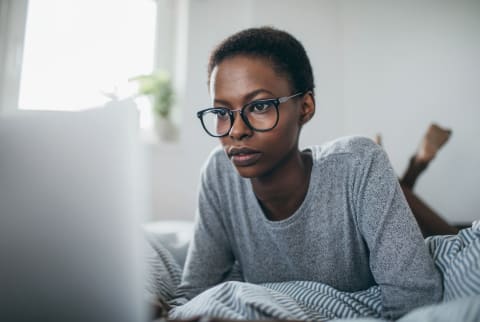Advertisement
Are Your Blue Light Glasses Actually Working? A Functional Eye Doctor's Trick To Tell


It's no secret screen time has soared during the pandemic1. Especially for those able to work from home, you might oscillate from virtual meetings to online happy hours to a feel-good TV series on Netflix. And repeat. With all this skyrocketed screen time, the thought might have crossed your mind once or twice: Should I invest in a pair of blue-light-blocking glasses? These lenses, meant to filter out the blue light in your surroundings, are practically exploding in popularity as we continue to bombard our retinas with LED-backlit screens—you can snag a pair for anywhere from $12 to $95.
Aside from the pretty penny, though, not all blue-light-blocking glasses are the same—meaning, some actually function better than others. "They all filter out different amounts of that blue light," says functional eye doctor Rudrani Banik, M.D., on the mindbodygreen podcast.
Don't sound the alarm just yet: Banik shares a helpful tip to determine whether your lenses are, in fact, doing their job. "[It's] a quick and simple thing, many people, don't realize that they can do."
How to tell if your blue light-blocking glasses are working.
First things first: Look at the lenses themselves. "If you see that the lens is pretty much clear, even light yellow, it's probably not blocking out most of that light," says Banik. Best to opt for darker-tinted lenses (think amber, orange, or even a deep red) to completely block out the blue light. That's not to say clear lenses don't help at all, but if you really want to up the ante, you might want to invest in a pair of ambers.
If you do already own a set of clear lenses, though, Banik does offer another trick to tell whether the glasses actually do their job well: "Put them on, then look at your screen at something that's blue. If you can still see that color blue, it means that it's not really blocking the blue light." On the flip side, if blue tones on your screen have an orangy hue, this means the lenses effectively omit the wavelength.
We should note that you don't have to necessarily block every single trace of blue light. Not all blue light is bad! It's chronic exposure that will typically affect your sleep cycle by interfering with melatonin production. On the day-to-day, it ultimately differs from person to person: Some feel just fine with a little filtered light, while others need the full-on amber-tinted lenses in order to concentrate. "It's really based on your comfort level," says Banik. "But I can tell you when I wear my denser blue blockers, I definitely feel the difference."
The takeaway.
Wondering if your blue-light-blocking lenses fall short? Try Banik's easy tip: If you can see the color blue, they're likely not filtering out all the blue light. Not a bad thing, but if you're looking for some heavy-duty blockers, you may want to opt for some orange-tinted sunnies.